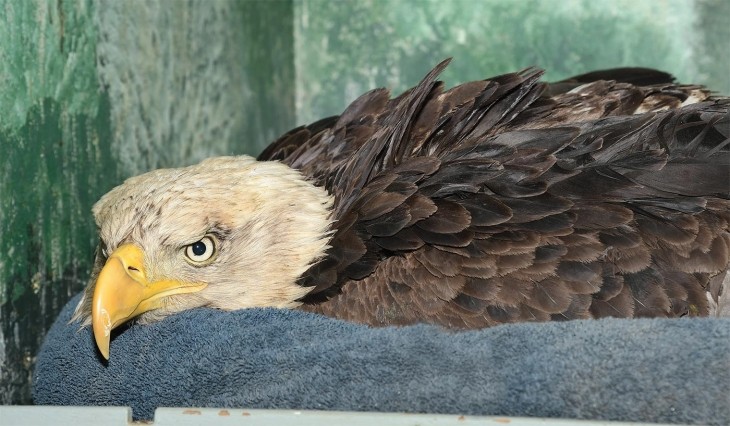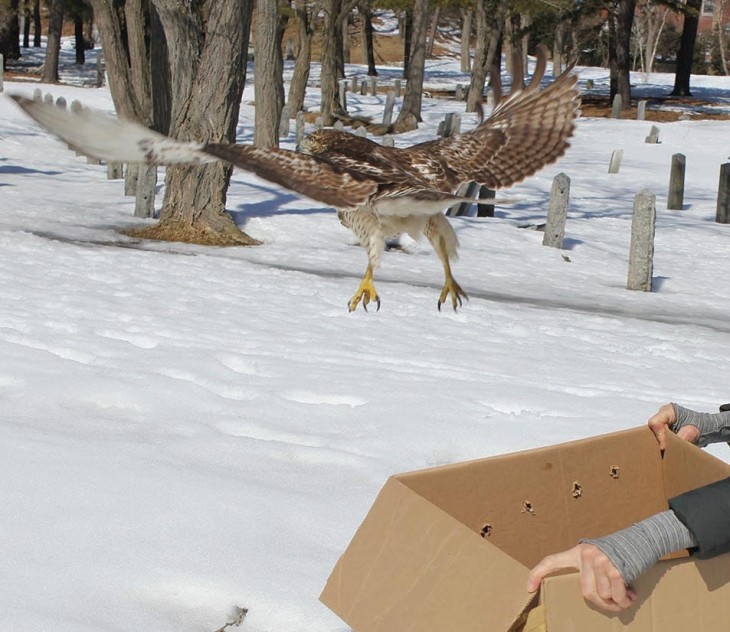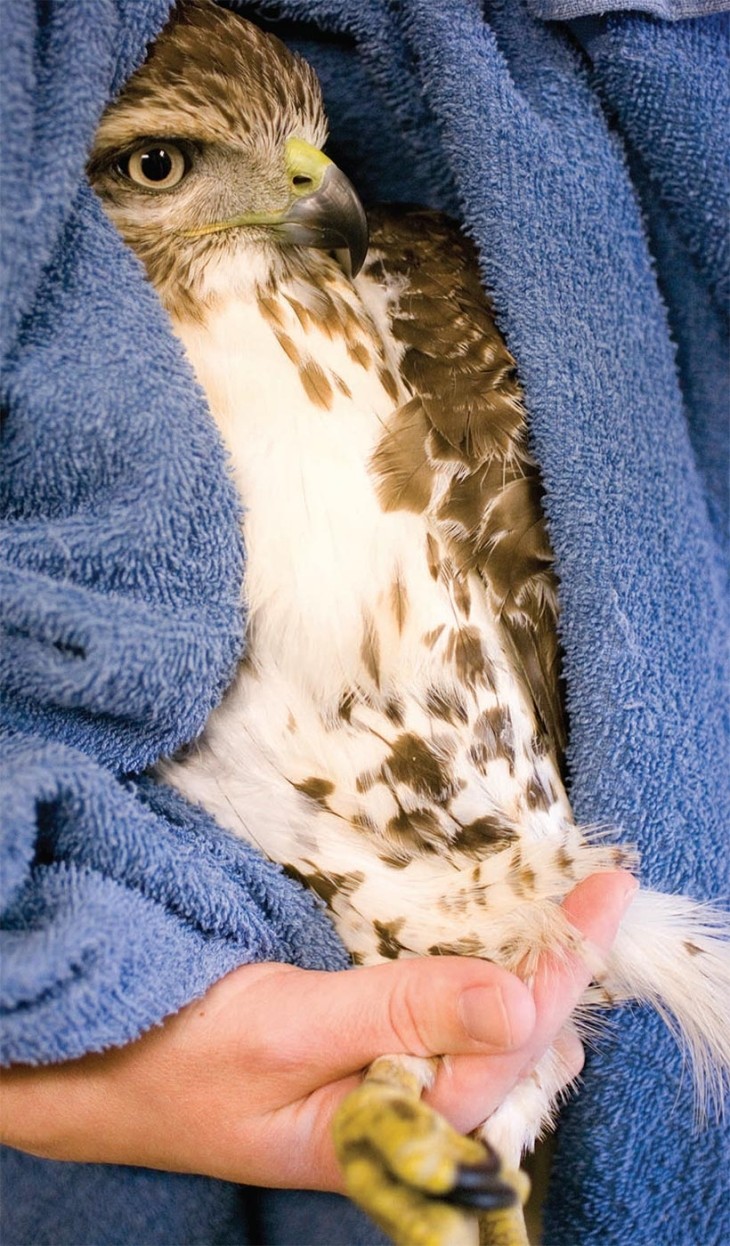
Being a wild bird rehabilitator requires something akin to parenting skills, combined with the grit of an emergency room doctor. The injuries and illnesses encountered are varied, as are the species that arrive in need of help. There is laundry to do – loads of it, every day – and continual food prep. There is heartbreak when things go wrong, and a sense of accomplishment when they go right.
“Every day is different,” said Grae O’Toole, lead wildlife keeper for the Center for Wild Bird Rehabilitation at the Vermont Institute of Natural Science (VINS) in Quechee, Vermont. “There’s nothing monotonous about this job.”
While wild bird rehab centers tend to be busiest from May to September, when baby birds are most abundantly in need of help, winter brings challenges beyond fostering fledglings. And with most songbirds migrated to warmer climes, rehab efforts often turn to raptors during the colder months when finding food becomes difficult for these birds of prey. Winter raptor rehab efforts range from treating emaciated hawks and car-struck owls to eagles suffering from severe lead poisoning and various raptors ill from secondhand rodenticide ingestion.
“Wildlife rehabilitators and wildlife veterinarians definitely see, every day, the many, many challenges that people have placed out there for wildlife as obstacles to their survival,” said veterinarian Maureen Murray, director of the Tufts Wildlife Clinic in North Grafton, Massachusetts, part of Cummings Veterinary Medical Center at Tufts University. “The different ways we are influencing these individual birds, and potentially their population, is pretty staggering. You see some pretty terrible things.”
For Murray, O’Toole, and other rehabilitators, it’s the potential for healing some of these wild birds and being able to set them free again that keeps them working through the challenges.
HUNGRY OWLS
The most common wintertime patients at VINS in Vermont are barred owls, which typically arrive after being hit by cars or because they’re emaciated. Healthy barred owls weigh less than 2 pounds and rely on their ability to detect prey moving beneath the snow and then punch through with their powerful talons to capture that prey. The hard, icy crust that develops during a winter of alternating thawing and freezing weather cycles hinders owls’ ability to break through and reach the subnivean rodents they rely on for food. Sometimes they shift their hunting efforts to near roadsides, where prey can be easier to catch, but which can also lead to devastating encounters with cars. Sometimes, the birds simply begin to starve.
The winter of 2018–2019 was a particularly big one for barred owl rehab. This is likely in part because of challenging winter conditions, and in part because there had been a barred owlet boom the previous spring. VINS accepted more than 60 barred owls that winter, contributing to a record year (2019) that included more than 700 avian patients. This year, they passed that record before summer’s end, although how many owls or other raptors O’Toole and her cohorts may treat this winter remains to be seen.
FAST HEALERS
If an owl is hit by a car, it may suffer leg or wing fractures, traumatic brain injury, or eye injuries. The first step to rehabilitation is an examination of the bird. Fractured wings can be wrapped, wounds dressed, and overall health determined. Because wild birds are generally stressed when handled, rehabilitators try to limit hands-on time and to keep their avian patients in a safe, dark place where they can heal.
“Birds of prey are incredibly fast healers,” said Murray. “They can heal a broken bone in two to three weeks. They are able to heal wounds and grow feathers back. It’s amazing to see the healing capabilities of these animals.”
O’Toole said the average stay for a raptor at VINS is 30 to 40 days, depending on the injury. “We try to really expedite the process,” she said, “because we don’t want them to be here and stressed for any longer than they need to be.”
Barred owls and other raptors that arrive emaciated are initially given fluids and then fed a liquid diet until rehabilitators deem it safe to introduce solid food. VINS has a food prep area with several refrigerators and customizes meals to each patient, with raptor menus ranging from chicken wings and quail parts to whole mice and rats.
Every patient has a folder listing medications, notes on specific injuries, and when the bird arrived. “We log how much food is given every day, if there are any leftovers, if they had any pellets, and even if the poop looked weird that day,” O’Toole said.
As they improve, birds move from the center’s intensive care unit – a warm, dark room with small compartments to keep birds from moving too much – to outside cages of increasing size. The final stop before being released back into the wild is the flight cage, an enclosure large enough for raptors to fly and rebuild their strength.
POISONED EAGLES
Barred owls are also frequent winter arrivals at Avian Haven, a wild bird rehabilitation center in Freedom, Maine. Perhaps more alarming, however, is the rising number of bald eagles coming in with elevated – and often fatal – levels of lead in their blood.
“The early winter of 2020 was probably our worst ever,” said Diane Winn, an avian rehabilitator and co-founder of Avian Haven. In January and February, the center took in 12 bald eagles. All either died or had to be euthanized due to lead poisoning or injuries sustained as a result of lead poisoning.
Eagles ingest lead when they feed on deer carcasses, gut piles, or waste meat from game butchers – sometimes used as coyote bait – that contain lead. When a lead bullet hits a deer, it shatters into tiny fragments, and many of these remain in the carcass of the deer.
“It does not take a whole lot of lead in a bald eagle to make it very sick,” said Murray. “The amount of exposure to lead among our wildlife species is something I think people don’t realize is still as widespread as it is.”
At Avian Haven, Winn said, rehabilitators have found a range of 20 ug/dl (micrograms per deciliter) to more than 65 ug/dl (the upper limit of Avian Haven’s screening instrument) in eagles. They also have treated birds that have fragments of lead in their gastrointestinal tracts. Treatment of lead ingestion and poisoning includes removing fragments through gastric lavage, which Winn said is basically a stomach flush, and treating affected birds with a chelating agent, which bonds with the lead and removes it from the bird’s system.

“The chelator will lower the eagle’s blood lead level and presumably prevent any further damage to body systems,” said Winn. “The problem is the damage that has already been done by the time we get the bird. The blood level we find on admission is just a snapshot of an ongoing process. We can chelate until the blood lead level is close to zero, but that does not fix problems that already exist and that are difficult, if not impossible, to diagnose in a living bird.”
These problems can include damage to the heart and the brain, as well as nerve damage. Lead-poisoned eagles often have compromised coordination, perception, and stamina, said Winn, which can lead to injuries such as falling from a perch or being unable to move from a roadside and subsequently being hit by a vehicle. Lead poisoning seems to be solely a winter issue.
“We virtually never see elevated blood lead levels outside the winter months,” said Winn. “While there is open water, eagles’ food is primarily fish.”
One way to alleviate the harmful affects of lead on bald eagles – and other wildlife that may feed on carcasses and gut piles – is to encourage hunters to switch to non-lead bullets and shot pellets. In a January post on its Facebook page, Avian Haven noted, “Making lead ammo illegal is a long way off in the state of Maine, but one thing that could be done fairly quickly is to regulate the proper disposal of the potentially toxic remains of all game killed with lead ammo – carcasses, gut piles, waste meat from game butchers…. If this meat could be kept out of the field, the problem for eagles would pretty much disappear. So you could propose that to your legislators as an interim solution.”
RAPTOR RISKS
Lead is not the only thing that can poison raptors. Murray said rehabilitators at the Tufts Wildlife Center often treat birds of prey that have been poisoned by anticoagulant rodenticides. People use this type of poison to rid houses and other buildings of rodents deemed pests, which die by bleeding to death after ingesting the poison.

“These types of poisons remain active in whatever animals ingest the bait,” said Murray, whose research has found widespread exposure among red-tailed hawks, barred owls, eastern screech owls, and great horned owls. “So, a bird of prey, or any other predator or scavenger that ingests the animal that directly ate the bait can also be poisoned.”
Murray said there is an antidote to treat this type of poison: vitamin K. Rehabilitators administer vitamin K, then continue supportive care through fluid therapy to replace the blood volume lost. Successful treatment, she explained, depends on the amount of poison ingested, as well as the site of the bleeding. And while some birds can be successfully treated and released, others do not recover.
Raptor rehabilitators see a wide array of other issues, both during winter and beyond. Winn said Avian Haven has treated birds – most often great horned owls – “loaded with porcupine quills,” likely after they’ve tried to eat a porcupine. Other cases are less routine. In January 2019, Avian Haven accepted a great black hawk, a species whose range is typically limited to the tropical climate of Central and South America.
Thousands of miles north of what should have been home, the hawk became a local avian celebrity after taking up residence in Portland’s Deering Oaks Park in late fall. For a while, he fared well, but when a severe winter storm hit in late January, the hawk was discovered lying in the snow by a cross-country skier who called Avian Haven.
The hawk had severely frostbitten feet, but otherwise seemed OK. Despite treatments, however, the hawk’s toes were so badly damaged that he was unable to use his feet or lower legs. A team of Avian Haven veterinarians and wildlife biologists made the difficult decision to euthanize the raptor that had captured the hearts of many park visitors and wildlife watchers. That decision is one that raptor rehabilitators often have to make.
“If we can’t fix a bird, if we have to humanely euthanize it, we have at least prevented it from suffering any further,” said Murray. “Being able to provide that end to suffering is still something that we can do for these animals.”
COMMUNITY EFFORT
Tufts, Avian Haven, and VINS all rely on volunteers to help with tasks from feeding baby birds in the spring and summer to transporting patients to their rehab centers. Volunteer transporters sometimes drive hundreds – even thousands – of miles in a year to help get injured or sick birds from where they’re found to where they can receive the help they need, hopefully to recover and be released again to the wild.
“We wouldn’t be doing what we’re doing without the people who actually take the time to pick up this animal and bring it to us,” Murray said. “Most often, it’s the general public who see an injured animal and take the time to stop and pick it up and sometimes drive quite a distance to get it to us. We’re here to accept that animal and try to restore it to health and get it back out there. The members of the public who take the time to assist that animal really deserve as much of the credit.”
While not all birds treated recover enough to be released to the wild, there is some middle ground between complete success and having to end an avian patient’s life.
“There are cases in which a bird in care may not heal properly enough to be released,” said O’Toole. “We reach out to wildlife centers across the United States to see if we may place those birds under the care of professionals so they may live out their lives as ambassadors for their species. In fact, many of the birds on the VINS campus are past rehab patients from our own rehabilitation center or from others.”
It’s the success stories, of course, that inspire wildlife rehabilitators to keep doing the work. “We focus a lot on the animals we do save,” said Murray. “There are a good number of these animals that we can restore to health and get back out there to live a normal life and contribute to their populations. Knowing that we have in some way mitigated our effects on some of the animals and are able to return them to the wild, that’s really rewarding.”
FEATHERED FOSTERS
At some wildlife rehabilitation centers, including Avian Haven, raptors that can’t return safely to the wild may be enlisted as surrogate parents. When sick or injured chicks or fledglings arrive, inevitably stressed and confused, these surrogates take on the role of brooding parent, keeping the young birds warm, keeping them company, and feeding them when they’re hungry.
“All orphaned raptors benefit from having surrogates,” said Avian Haven’s Diane Winn. “Even if a foster does not feed the chicks, he or she will brood or otherwise accept the close proximity of the youngsters. That helps the orphan feel safe and secure in its new environment.”
But surrogate raptor parents have a role to play beyond offering comfort. Seeing adult birds of their own species allows chicks to imprint – or, as Winn put it, “acquire the appropriate species identity.” Essentially, a bald eagle chick will learn it is a bald eagle by being with the appropriate surrogate, while a barred owl will understand it’s a barred owl by spending time with that species.
“Older juveniles that do not require brooding and that have imprinted properly continue to benefit from the presence of an adult role model that displays appropriate adult behaviors and encourages them in the raptor equivalent of the ‘teenage’ years,” Winn said.
Avian Haven’s raptor surrogates currently include bald eagles, barred owls, and great horned owls. The surrogates are typically birds that arrived at Avian Haven ill or injured and have recovered, but not enough to be released to the wild. One example from a couple of years ago was Trescott, a female bald eagle that arrived with lead poisoning. Although she could not safely return to the wild (and died in 2019), Trescott fostered four young eagles that did make full recoveries.






Discussion *